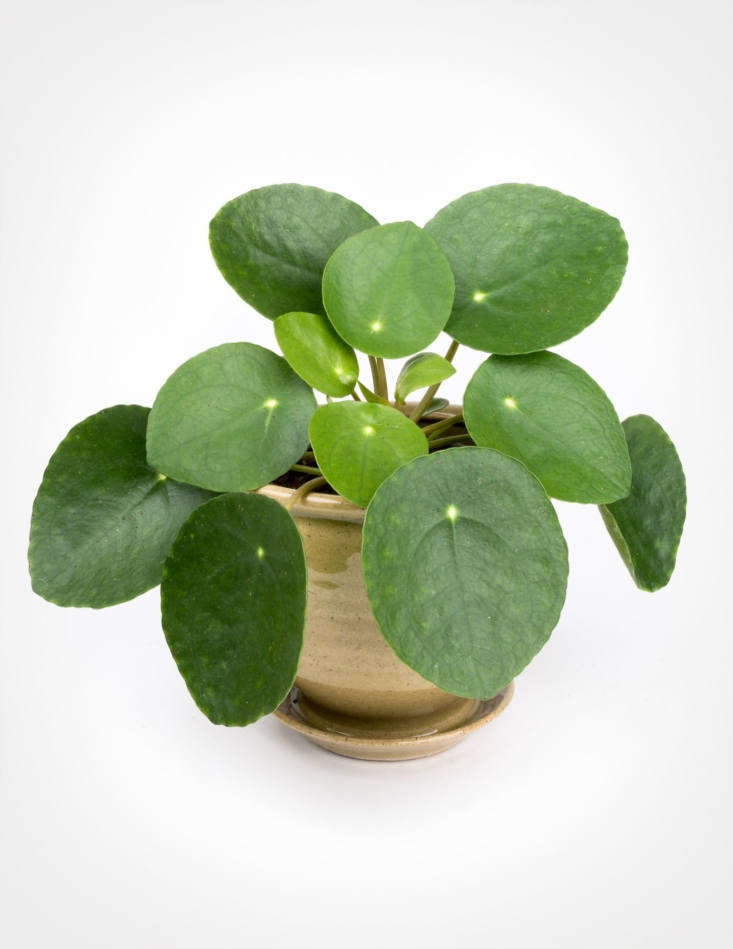Pilea, Pilea peperomioides: “Pass-along Plant”
As common as a Kardashian, photogenic Pilea houseplants dominate the conversation on Instagram. What makes this friendly, pancake-leafed houseplant so popular? Those pancake leaves, for starters. What could look cheerier than flat, smooth, round disks bobbing at the end of politely arched stems? Pilea peperomioides looks happy to see you every time you walk into the room, and its diminutive size at maturity promises that it will always be your baby.
No wonder pilea plants have so many nicknames. In addition to the obvious “pancake plant” (as in “Good morning, little pancake plant”), P. peperomioides also may be labeled as “UFO plant” or “Chinese money plant” in a shop. (Why “money plant?” The shiny, leathery leaves stack on top of each other, looking like coins. Plus, there is a belief that if you place a coin in the soil, it will bring you wealth. Please report back if anyone finds this to be true.)
And if you happen to see in Scandinavia (where Pilea is as ubiquitous as fiddle-leaf fig trees are in the US), don’t be surprised to hear it called “lefse plant,” a reference to a local pancake-shaped potato bread of the same name.
Is Pilea your next houseplant? Please keep reading to learn more about your new easy-care and photo-friendly friend:

From its home in mountainous regions of China, where it nestles in limestone gorges, Pilea peperomioides made its way to Europe in 1946 when Norwegian missionary Agnar Espegren brought a specimen home in a box. The plant flourished and over the years Espegren shared cuttings with family and friends, singlehandedly transforming Pilea into one of Scandinavia’s most popular window sill plants.

These days, most houseplant collectors still get their first baby pilea from a friend, as propagation is easy and until recently the species was not widely available in plant shops or nurseries in many countries, including the US. (If you’re wondering why you can’t buy a pilea at every Ikea store in the country, read our recent interview with Ikea’s top US plant buyer, in An Insider’s guide to Getting First Dibs on the Best Houseplants.
In recent months, luckily, availability of pilea plants has become widespread and well-priced specimens are available from such online sellers as The Sill, Pistils Nursery, and Etsy vendors.

After you get your hands on a Pilea, make sure the container or pot it lives in has holes in the bottom as it needs well-drained soil. Situate the plant in bright light (no direct light–or scorching will occur). You also may want to put your plant pal outdoors when temperatures warm up, but keep it out of direct sun.

Pilea is a cinch to propagate. A thriving plant will give you plantlets (actually, basal shoots that grow from the roots) which you can carefully separate from the mother plant by using a clean, sharp knife. Plant the baby in well-draining potting soil and keep well-watered until new leaves emerge. Little ones also grow from the stem and can be cut and rooted in water. Then you can pot those up and give them away, spreading the wealth to friends and family.

Cheat Sheet
- Pilea peperomioides grows to a height of 12 inches and leaves will be larger with less light.
- The perfect office co-worker, pileas thrive in artificial light.
- Try pilea on a windowsill where it will appreciate a low-light, dry spot. Keep the plant out of direct sun rays.

Keep It Alive
- It’s time to water P. peperomioides thoroughly when the soil is on the dry side. Tip: Droopy leaves mean that the plant needs water.
- The flat, round leaves can accumulate dust so give your plant friend a regular shower or at least wipe down the leaves.
- Rotate a pilea plant frequently so that it doesn’t grow lopsided as it leans toward light.
- Feed plants monthly during the spring and summer growing seasons with an all-purpose plant fertilizer.
- You can grow P. peperomioides outdoors in USDA growing zone 10 in partial or full sun (so long as temperatures don’t drop below 40 degrees Fahrenheit).
Read more growing tips in Pilea: A Field Guide to Planting, Care & Design in our curated guides to Houseplants 101. Read more about how to assemble an Instagram-worthy houseplant collection:
- Living with Houseplants: At Home with Summer Rayne Oakes in a Brooklyn Apartment
- Best Houseplants: 9 Indoor Plants for Low Light
- Still Life with Houseplants: Macramé Artist Emily Katz in Portland, Oregon
- ZZ Plant: A Field Guide to Planting, Care & Design
- 10 Things Nobody Tells You About Trendy Houseplants












Have a Question or Comment About This Post?
Join the conversation (0)